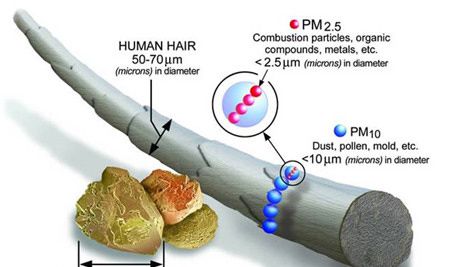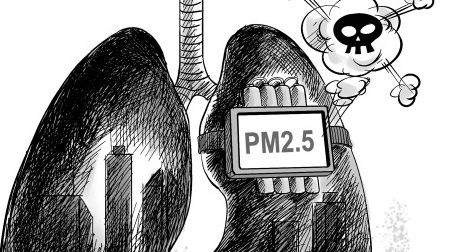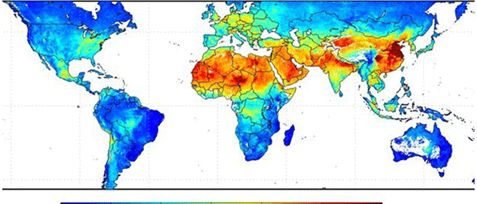PM2.5——看不见的杀手
爱思英语编者按:PM2.5是指大气中直径小于或等于2.5微米的颗粒物,也称为可入肺颗粒物。虽然PM2.5只是地球大气成分中含量很少的组分,但它对空气质量和能见度等有重要的影响。PM2.5粒径小,富含大量的有毒、有害物质且在大气中的停留时间长、输送距离远,因而对人体健康和大气环境质量的影响更大。
PM2.5: Invisible Killer
Air monitoring data from the US Embassy in Beijing started circulating on micro blogs suggesting the density of PM2.5 was about 250 to 350 on Oct 30, 2011. And the general air pollution index was 425, reaching the level of "poisonous". However, the index released by the municipal environmental authority that day was only 132 and the air was categorized as "lightly polluted". Why the air monitoring data published by Beijing government and US Embassy are so different? What is PM2.5? What does it have to do with us?
What Is PM2.5 and PM10

We can all appreciation what pollution is and specifically pollution that′s in the air refered to as particle pollution. Particle pollution is also known as "Particulate Matter" or simply PM. While the term PM is simple, PM itself is a relatively complex mixture with extremly small particles and liquid droplets that float around in the air.
There are two kinds of particle pollution, fine particles and inhalable coarse particles. Fine particles are called PM2.5, because their size is 2.5 micrometers in diameter and smaller.
Inhalable coarse particles are called PM10, because their seize ranges from 10 micrometers down to larger than 2.5 micrometers.
What Is The Harm of PM2.5

High PM2.5 linked to deaths: researchers
Researchers from Peking University say minute particle pollution as indicated by high PM2.5 readings will cause a spike in the mortality rate of patients suffering heart and lung diseases.
Because fine particles(PM2.5) is much smaller than inhalable coarse particles(PM10), its negative effects on human health is more severe.
When we breathe, the fine particles can reach the deepest regions of our lungs. And exposure to particles is linked to variety of significant health problems, ranging from aggravated asthma and one in this scale to pre-mature death in people with hard disease on the other. PM2.5 is worthy the name of "Invisible Killer".
Global PM2.5 Pollution Index

The Global PM2.5 pollution index map was drawn by Canadian scientists according to NASA satellite data.
In the map, colors change from dark blue to light blue, yellow and dark red, which represents that the concentration of PM2.5 becomes more and more high.
From the map we can see that air pollution has been an unusually austere problem in China, especially in the north and east.
World PM2.5 Restriction Standards
Concentrations of chemicals floating around in the air are particularly measured in the units of the mass of the chemical per volume of air. In this case, the unit of the mass of the chemical is measured in micro grams in the volume of air in cubic meters.(1 gram=1000000 micrograms)
The World Health Organization(WHO)
The World Health Organization issued "Air Quality Guidelines" for fine particles in 2005. The recommended standard for PM2.5 is no graeter than 25 micrograms per cubic meter are allowed within the 24-hour period of time, and 10 micrograms per cubic meter are allowed within the aunual period of time.
The United States
The Environmental Protection Agency(EPA) issued PM2.5 concentration standard in 2006, the standard is no greater than 35 micrograms per cubic meter are allowed within the 24-hour period of time. Within the annual period of time, the restriction is no greater than 15 micrograms per cubic meter.
The Europe Union
EU released PM2.5 standards on July 1, 2010. The restriction is no greater than 25 micrograms per cubic meter within the annual period of time. And the standards will put into force on July 1, 2015.
PM2.5 Monitoring in China
The Chinese State Council passed revised air quality standards which include an index for PM2.5 on February 29, 2012. The new standards include indices for the concentration of PM2.5 and ozone (O3) over a period of eight hours.
In 2012, the monitoring of PM2.5 and O3 will be conducted in four municipalities, 27 provincial capitals, as well as three key regions -- east China's Yangtze River Delta, south China's Pearl River Delta, and Beijing-Tianjin-Hebei area in the north.
In 2013, the monitoring will be extended to 113 model cities on the state environmental protection list.
In 2015, the monitoring will be extended to all cities at prefecture level or above.
The government work report delivered by Premier Wen Jiabao at the Two Sessions also raised targets for monitoring PM2.5 in China. PM2.5 had been a hot topic at the Two Sessions.